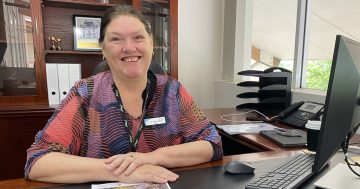
Jarvis Hayman’s extensive research and writing has led to the publication of three books on decomposition of the human body and the estimation of time of death in Australian conditions. Photo: John Thistleton.
Bodies alive and dead fascinate Jarvis Hayman. The Scottish-trained surgeon healed people in Goulburn for 25 years before opening, studying and autopsying dead bodies for his extensive research and writing.
Educated at Robert Gordon’s College and the University of Aberdeen, he grew to love history, geography and English and has never forgotten the moment he first learned of Australia’s enormous potential as a country of seven million people in the 1950s.
His mother’s care of a dependent aunty with cerebral palsy stirred his early interest in medicine. Progressing through his medical studies and meeting his future wife and nurse at the time, Rosemary, the couple shared a compelling interest in Australia.
They sailed for six weeks before settling in Ballarat where he was appointed senior resident medical officer for two years. He earned twice as much as he had been making, received more practical training and loved the lifestyle of a regional centre.
At the completion of his Ballarat tenure the couple returned to Scotland for four years before coming back to Australia where Jarvis filled a temporary vacancy at the Prince of Wales Hospital. The Haymans then moved to Goulburn with their three young daughters during a cold January 1976.
“I’ve always been a practical surgeon, hands on, not an academic surgeon and that’s the highlight of it all,” he said. “That’s why I wanted to be a rural surgeon.
“Getting to know your patients, getting them better, operating on them, making sure they were OK and seeing high risk patients years after and they’re still walking down the street, that’s very satisfying,” he said.
Like his fellow Goulburn surgeons, he fought health authorities for new instruments to enable services to keep up to date. He trained weekly, worked through lists of patients at Prince of Wales Hospital needing colonoscopies and attained his certification. “I had a fight to get a colonoscope for Goulburn,” he said.
Jogging around St Pat’s College oval one Sunday afternoon in 1994, he dismissed tightness in his chest, swept aside his shortness of breath walking up steps at the hospital, but after bounding into the surf at Rosedale Beach later on holidays he could no longer ignore the pain.
Colleague Max Williams later sent him immediately to a Sydney cardiologist who discovered a 90 per cent blockage in the origin of his main artery. He underwent bypass surgery.
“I didn’t think I was under stress, but you are,” he said. “When you are at the operating table for hours, the adrenalin is flowing, you’ve got to keep your cool and that is stressful.”

Rosemary Hayman had always wanted to go to Tasmania, while Jarvis Hayman was from an early age sure Australia was a country of enormous potential. During their first years away from their homeland of Scotland they decided on making their new home in Goulburn. Photo: Hayman family.
Arthritis hurt his hands and an old rugby injury in two fingers didn’t help. In 2001 he retired from surgery.
Seeking advice from an eminent primatologist, Professor Colin Groves at the Australian National University in Canberra about studying archeology, Jarvis was told he had to start from the bottom. That was fine, he said.
Completing a basic graduate diploma with the distinctions needed for his masters, his new life as a researcher was underway.
“I found it fascinating, especially landscape archaeology around NSW; I used to travel around looking at old towns and buildings and so on,” he said.
He returned to Scotland and wrote his thesis for his masters on the archeology of the Scottish Highland clearances – land cleared of tenants and their cottages to make way for large sheep farms. He elected an area at Strathnaver for his study and thesis.
“Then I decided I would like to marry my archeology with my medical (studies) and that’s how I fell into human decomposition,” he said.
Accessing the National Coronial Information System’s database, he began formulating a question in his mind to guide more research and attended the Victorian Institute of Forensic Medicine in Melbourne for a month.
“Every day I used to go in there with the pathologists and watch them doing autopsies on decomposed bodies. That was fascinating,” he said.
Winning a scholarship for more study in America, he engaged a builder to erect a purpose-built shed, and sat waiting for the donation of a dead body he could study, while it decomposed.
After several days of decomposition, and with students observing him, he performed an autopsy, keeping his sense of humour all the while.
“I must say that was the easiest operation I have ever done – it didn’t require an anaesthetist,” he said with a wry chuckle.
His quest for knowledge throughout his career has meant Jarvis has always felt comfortable in a room full of dead bodies.
Original Article published by John Thistleton on About Regional.














